 In modern orthodontics there is a wide variety of additional devices with which you can correct dentoalveolar pathologies and correct the broken bite.
In modern orthodontics there is a wide variety of additional devices with which you can correct dentoalveolar pathologies and correct the broken bite.
One such device is the palatal cleavage. Translated into Russian, this word denotes an arc, because of which the whole structure was called the palatal arch. This wire arcuate apparatus, which is installed close to the palate. Its main purpose is to correct and correctly fix the molars on the upper jaw, that is, to correct their position and then strengthen it.
With the help of this design, the teeth return to anatomically correct place, as a result, a person gets a healthy and beautiful smile.
The palatine arch is part of many orthodontic devices( Gozhgarian's apparatus and Quadrohelix, Nansse button and others).Often experts use the palatine bugel along with the braces.
Contents
- How it works
- How it works
- How it works
- How it works
- How it works
- arc design
- ASG design.life
- Cost of treatment
- How it works
- How it works
- How it works
Principle of operation
The palatal bustle, like most other orthodontic structures, is most effective in prescribingand adolescence. Young teeth respond much better and faster to changes in the course of treatment, rather than the jaw of adults.
The design is a non-removable element. The time of wearing it can vary depending on the complexity of the clinical picture.
In most cases, wearing a clasp is shown with the braces. Thus, it turns out to achieve a slight change in the location of the chewing teeth.
The device is attached a short distance from the sky to the molars. To install, mainly used rings. Depending on the pathology, the design is designed to restrain the displacement of the dentition, or, conversely, help him move to the right place.
Decides that the bite needs to be adjusted by the doctor - orthodontist. At the reception of a specialist, an examination is carried out, during which the 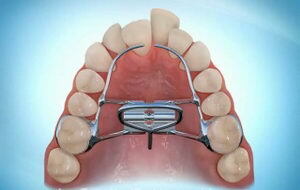 assesses the general condition of the oral cavity. An orthopantogram is mandatory, as a result of which the doctor receives a panoramic photograph.
assesses the general condition of the oral cavity. An orthopantogram is mandatory, as a result of which the doctor receives a panoramic photograph.
The construction is made of a special alloy, which does not cause irritation of the mucosa. After a period of addiction, which lasts no more than two weeks, speech is restored. If you carry out special exercises, the adaptation process ends even faster. Unpleasant sensations from the presence of foreign matter in the mouth disappear.
Design features
By design, this wire arc, with both ends of which are rings that act as fasteners. Depending on the technical features of a certain model, the rings can differ in the way they are fastened, starting with the usual locks and ending with contact soldering.
At first glance, the whole design may seem rather inconvenient, limiting human capabilities. The patient thinks that it will be problematic for him to eat and will have an unpleasant speech defect. This opinion is only partially true.
After setting the arc for the first two weeks, the patient will need time to get used to it. At the end of this time, all sensations of discomfort when worn pass.
The palatine structure is made of a metal alloy, which is a hypoallergenic material. But in rare cases, there is a rejection of the arc because of the allergic reaction that has appeared. The location of the structure is the area between the far lateral teeth to which it is attached. There are no auxiliary elements, screws, springs for the clasp.
Arc assignment
The wearing of the machine is assigned to correct the location of the teeth. Bugel has three main functions:
- rotation molars( during the correction of the occlusion, the teeth return to the correct place);
- displacement of the position of molar molars;
- increase in the stability and reliability of the support( simultaneous correction with tooth removal).
Types of structures
The palatine canopy is part of numerous orthodontic devices, the application of which is aimed at restoring the right bite. There are several basic types of apparatus that are most often used in orthodontics.
Arc of Gozhgarian or Zeitlin
This is a metal wire that acts as a fixative for chewing teeth. The palate of Gozhgarian is often used simultaneously with braces.
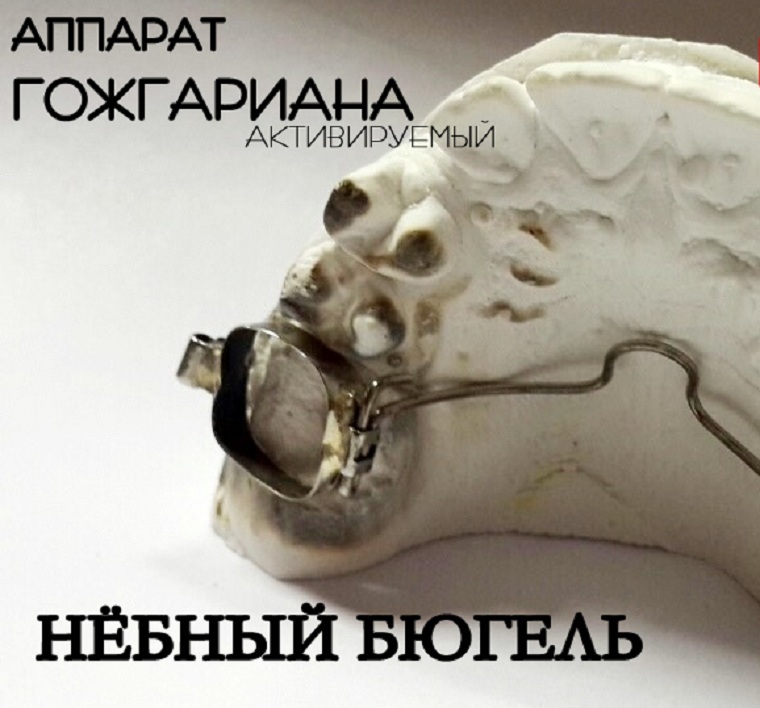
Palatine extender
In the palatine expander there is additionally a spreading screw. Indications for its use are the following cases:
- to expand the upper jaw;
- lengthen the dentition;
- rotate around its axis lateral molars.
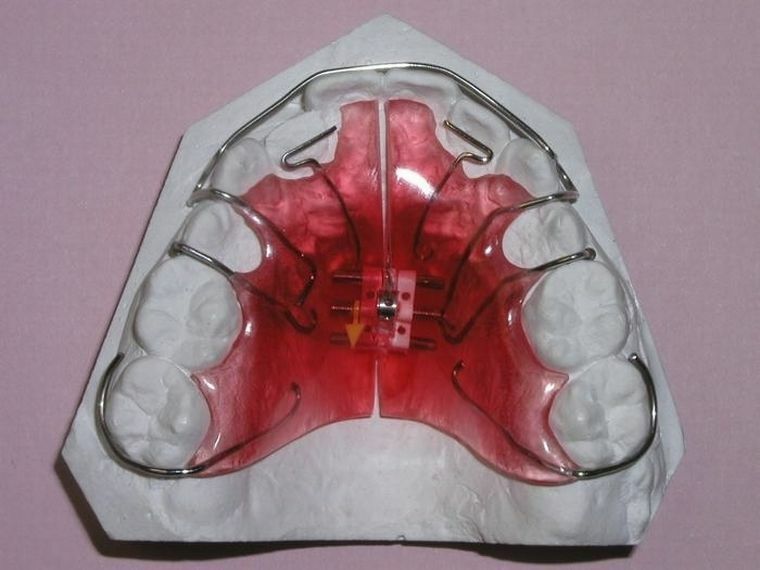
This model has its own variants - the devices of Derichsweiler, Khayreksa.
Button Nansse
In this model there is an additional button made of plastic, which is located in the area of the tubercle of the upper palate behind the front teeth. It is assigned the function of a kind of abutment, due to which the device acts on the chewing upper teeth.
As a result, when you remove neighboring units, the rest of the dentition is not damaged, does not move. It also helps if the teeth have been moved before that.
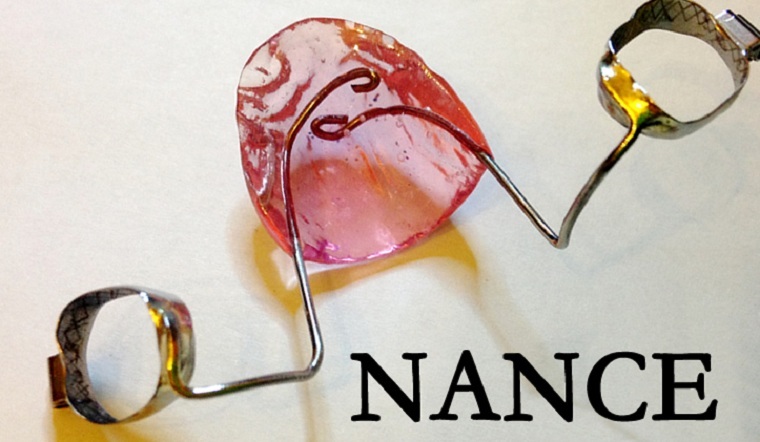
Pendulum - Pendex
This device has an additional plastic plate that is responsible for expanding the upper jaw. Especially effective is the device in the treatment of adolescents, and for older people. With the aid of the plate, the lateral teeth move backward.
Quadrohelix is one of the types of palatal clasp
Quadrohelix is one of the types of the palatine arch, with which the jaw is expanded from above, and the location of the side units is corrected and fixed in the desired position.
This model is assigned in the following cases:
- bite correction( regardless of patient's age);
- jaw extension from above;
- elongation of a row of teeth from above;
- can slightly adjust the position of the lateral dental units;
- fixation of the position of the chewing teeth;
- increased interdental distance;
- with minor pathology can self-correct bite;
- before starting the main treatment for orthodontists;
- for simultaneous wearing with braces.
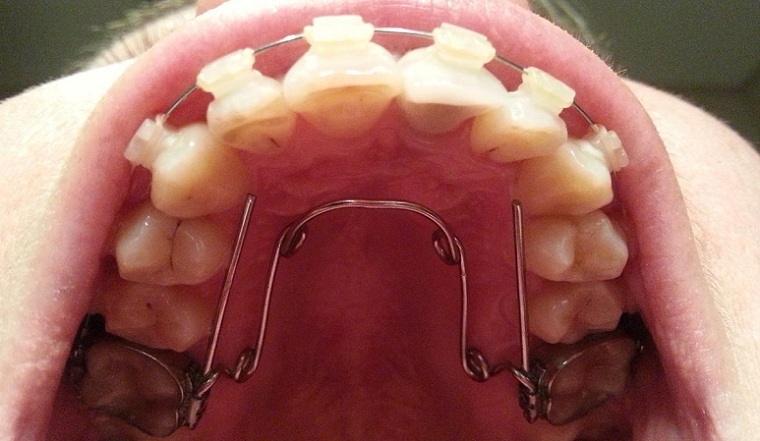
The device consists of a wire and four additional springs, which act as spacers to move the teeth to the correct location.
The design simultaneously affects all teeth. If necessary, the main load falls on the front or chewing dental units. Fixation of the device takes place on the molars with the help of round metal loops.
Installation and Treatment Process
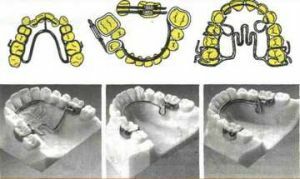 The installation process is relatively short-lived. If necessary, the patient should be treated teeth, cleansing of bacterial deposits, to stop inflammation of the oral cavity.
The installation process is relatively short-lived. If necessary, the patient should be treated teeth, cleansing of bacterial deposits, to stop inflammation of the oral cavity.
After this, the doctor studies the location of the teeth, the causes of the pathology, the state of health of the bite. In some cases, it may be necessary to level the occlusive surface.
The clamping device is installed in several stages:
- definition of those teeth, which in the future will serve as a support for fixing the arc;
- preparation of the tooth surface for the installation - treatment, turning;
- procedure for removing the impression of the jaw;
- the apparatus is manufactured according to the sample obtained from the impression;
- follows the first fitting of the design;
- , if necessary, the product is adjusted, taking into account the results of the fitting;
- installation of the device and fixing it on the teeth.
The whole installation procedure takes from 7 to 10 calendar days.
Patients quickly get used to the presence of a foreign object in the oral cavity. All due to the fact that the design uses a special wire of small cross-section. The wire itself has such properties that prevent the impact of an aggressive environment.
In addition, the material used for its manufacture does not enter into chemical-biological reactions. Therefore, no irritation in the oral cavity is formed, soft tissue is not damaged.
For a short time after the installation, the patient may have a speech disorder, but soon it passes. The phenomenon is short-lived and provoked by the appearing interference to the movement of the tongue. After a period of adjustment, speech functions are completely restored.
Advantages and disadvantages of the
design The use of the palatal arc in orthodontic treatment gives patients several advantages:
- simple compliance with daily oral hygiene;
- high aesthetics, since the design is not visible to surrounding people;
- the effectiveness of treatment, especially with simultaneous wearing with braces;
- comfortable wearing;
- short term treatment, wear the device only a few months;
- fastest addictive, thanks to the small size of the design.
Among the shortcomings can be noted only the violation of diction in the initial period after installation.
The device can be used by almost all people, except for patients with mental disorders, diagnosed with immunodeficiency, and in the presence of pathology of bone tissue.
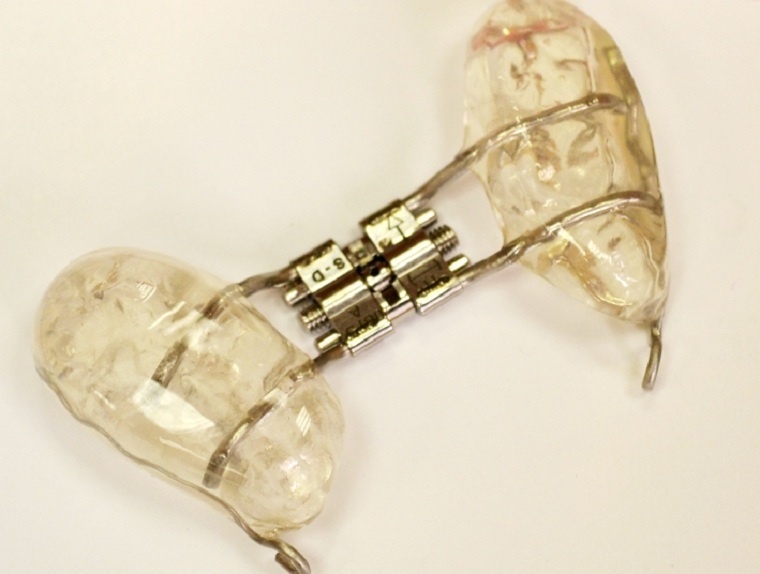
On the photo the palatine with the screw Khayreks
Cases from the life of
Testimonials of visitors of our site who are faced with the action of the palatal clasp in real life.
My friend went with such a thing. I remember that instead of eating, she ate only pills for analgesia. She stopped using toothpaste, and only rinsers became her salvation.
So I do not know what's written here, that they do not hurt, I was a real witness to the torment.
Karina, 29
Three years ago I had to get acquainted with this record. Finally I decided to level the teeth by the age of 25.Nothing wrong with that.
Yes, you start to lisp a little, what then passes, when you get used to it and learn how to speak anew. But it is not visible from the side in the process of conversation, due to which I was deprived of unpleasant gaze.
Nina, 37
Cost of treatment
Prices vary depending on the specific model and start from 6 thousand rubles.
The palatine can help restore the smile's beauty and health to the teeth, it will not take long to wear it, but the result will remain forever.
